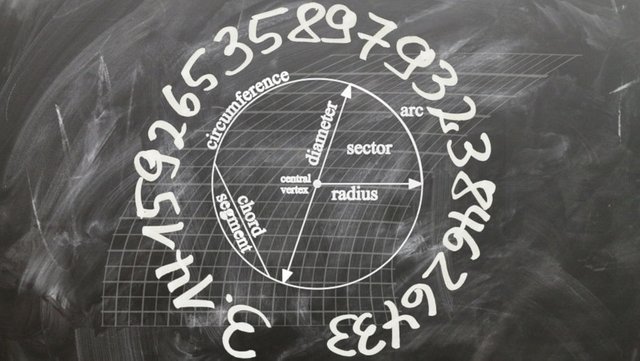Becoming Pi
I once was flabbergasted to learn that in nature there's no such thing as a perfect circle; they just don't exist, not on large scales in planets, suns or black-hole event horizons nor on small scales.

source: Wikimedia Commons
Archimedes had a clever idea and decided to use regular polygons with equal sides and angles to estimate Pi's value. A circle is a shape in which every point on it's outline is equally distant from it's center. The ratio between the length of it's circumference and diameter is π, symbolized by the classical Greek letter. The story of this number is as old as human civilization itself, or at least dates back to the Babylonians and Egyptians more than 4000 years ago. The Babylonians estimated Pi to be three and one-eighth or 3.125, while the Egyptians came to a value of 3.16. This is not too bad at all considering the real value is 3.1415926 followed by an infinite number of more digits; Pi is an irrational number, or an "infinite decimal" number, and there's no simple fraction that equals Pi. Pi will therefore always be an estimate, although a very accurate one nowadays.
The more sides you add to the polygon, the closer it resembles a circle: a pentagon is "rounder" than a square, and and octagon is rounder than a heptagon, and so on. A circle is a regular polygon with infinite sides of infinitesimal length. Taking the square as a starting point, draw a circle around the square with it's corners touching the circle, and a circle inside the square, with it's sides touching the circle. You then measure the circumference and divide by the diagonal diameter between opposite corners, and then by the horizontal diameter between opposite sides, and you have an estimate of Pi, albeit a very inaccurate one with a wide range. By adding more sides, the diameter between opposite sides and the diameter between opposite corners becomes smaller and the estimate becomes more accurate with an ever smaller range. Using this elaborate method (aptly called the method of exhaustion), Archimedes came to an estimate of somewhere between 3.1408 and 3.1429, using a polygon with 96 sides.
This method of exhaustion was used for a very long time and all over the world. With a polygon of 3072 sides Chinese mathematician Liu Hui calculated Pi to be 3.1416. Only two centuries later a polygon with 12,288 sides was used to add another decimal to Pi at 3.14159. This precision record stood for 800 years before finally being bested, mainly by the introduction of algebra. Using equations Austrian astronomer Christoph Grienberger calculated Pi to 38 decimals, using a polygon with 10 to the power 40 sides (a 10 with 40 zeros!!)...
Then came the discovery of infinite series, with which Pi can be calculated as an infinite sum, becoming more precise with each addition in the series. Here's a short list with Pi-records:
- 1699, Abraham Sharp - 71 digits
- 1706, John Machin - 100 digits
- 1719, Thomas Fantet de Lagny - 112 digits

source: Max Pixel
They developed different infinite series which converged on Pi more quickly than previous ones. So the "contest" was not decided anymore by who could do the most calculations, but who came up with the fastest converging series. When the first mechanical computers came out, the calculation of Pi became a lot easier, and in the late 1940s Pi was calculated to 1012 digits. With the introduction of electronic computing it has become a series of newer, faster computers spitting out Pi after a long time calculating; in 2010 there was this headline: Pi record smashed as team finds two-quadrillionth digit. I don't know the most recent record, or maybe that was the latest... But we're still going at it. Why? I think for the same reason we try to climb higher mountains or run a faster mile; because we can and humans are always curious about what's behind the next hill. We boldly go where no one has gone before, even in the abstract landscape of perfect mathematical circles.
Thanks so much for visiting my blog and reading my posts dear reader, I appreciate that a lot :-) If you like my content, please consider leaving a comment, upvote or resteem. I'll be back here tomorrow and sincerely hope you'll join me. Until then, keep steeming!

Recent articles you might be interested in:
| Latest article >>>>>>>>>>> | Out Of Control |
|---|---|
| One Of Those Days... | Raise Taxes! |
| Possible And Impossible Futures | Attention Span Of A Goldfish |
| May The Force Be With You | Google Limits Speech... Again |

Thanks for stopping by and reading. If you really liked this content, if you disagree (or if you do agree), please leave a comment. Of course, upvotes, follows, resteems are all greatly appreciated, but nothing brings me and you more growth than sharing our ideas. It's what Steemit is made for!


Just for Full Disclosure, I'm invested in these crypto-currencies:
Bitcoin | Litecoin | EOS | OmiseGo | FunFair | KIN | Pillar | DENT | Polymath | XDCE | 0x | Decred | Ethereum | Carmel | XYO

@helpie is a WITNESS now! So please help @helpie help you by voting for us here!

Very interesting thanks :)
Posted using Partiko Android
I'm glad you liked it @j85063 😋 Thanks for the support!
Solid article m8 :)
Thanks for the kind words @k0wsk1, it's much appreciated! 😊 😋
Congratulations @zyx066! You have completed the following achievement on the Steem blockchain and have been rewarded with new badge(s) :
Click here to view your Board
If you no longer want to receive notifications, reply to this comment with the word
STOPTo support your work, I also upvoted your post!
I believe the formula (for k-> infinity) is "k/tan(90-180/k)" or "k*sqrt(1/sin(90-180/k)^2-1)
I just spent an hour I should have spent studying maths for my first economics semester trying to find a formula to caluclate Pi :D